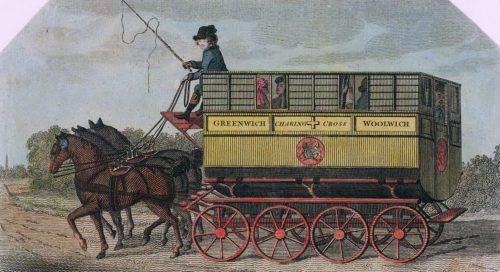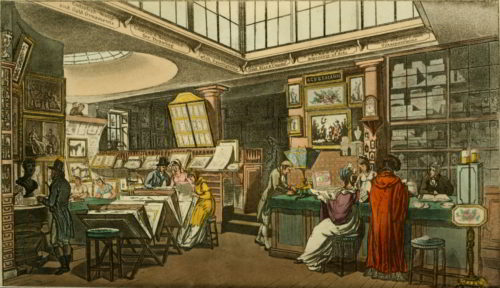
Regency Era bookseller, inventor, lithographer, publisher and entrepreneur.
Born in Saxony in 1764, fans of Jane Auston recognize Rudolph Ackermann for his famous Repository of Arts, Literature, Fashions, the source of a multitude of home and garment fashion plates that have shaped our image of the Regency era world. However, Ackermann was far more than a mere publisher.
He began his career as a saddler, like his father, since he could not afford a university education. By the time he was 23, he had added coach-builder to his resume and settled in England. He set himself up in the center of English coach building, near Covenant Garden where his flair for design and acumen for self-promotion landed him a contract to design a ceremonial coach for the Lord Chancellor of Ireland. Later, he was employed to decorate the existing coach of the lord mayor of Dublin, designed a state coach for George Washington in America., and designed an 8-wheeled horsebus (omnibus) that traveled between Charing Cross, Greenwich, and Woolwich in London. In 1804, a carriage of his design carried the pope to the coronation of Napoleon Bonaparte in Paris.

In 1791 he published Imitations of Drawings of Fashionable Carriages to promote his coach-making business, but it opened the doors to an entirely new phase of his varied career, artist. Just four years later, in 1795, he married an English woman, Martha Massey (who died in 1811, after giving him nine children), and established a printshop, The Repository of Arts, and revived William Shipley’s drawing school, in a property near the Royal Academy of Arts.
In 1799 Ackermann to manufacture and sell his own watercolour paint blocks. Though other colourmen supplied his paint blocks, he went on to create (develop and mix) three of his own colors, Ackerman’s Green, White and Yellow. By 1817, his eldest son, Rudolph jr. had taken over this side of the business. By 1825, Ackermann established Rudolph jr. in a print shop in Regent Street

(The advertisement suggests he also sold brushes, and pencils and in later years, canvases, papers and even some supplies for oil painting as well as ‘Boxes of Colours for Velvet-Painting’.) While developing his artist supply business, he also added a lithographic press to his ventures and began a trade in printmaking and book publishing, working with Cruishank, Rowlandson and other artists of the day.
His publishing ventures took off to such a degree that in 1806 he had to shut down his drawing school to give his attention to his publishing. In 1809, his famous Repository of Arts, Literature, Fashions began its twenty-year run. Also among his publishing credits were the parody Dr. Syntax in search of the Picturesque, The English Dance of Death, The Microcosm of London (3 volumes, 1808–1811), Westminster Abbey (2 volumes, 1812),The Rhine (1820), The Seine (1821),and The World in Miniature (43 volumes, 1821–1826).

As an inventor, he patented the Ackermann steering geometry for carraiges (1820) and a method for making paper and cloth waterproof (1801) and built a factory in Chelsea to produce it.
During the Napoleonic wars, he contributed to British propaganda efforts, publishing anti-Napoleonic materials and military manuals. After the Battle of Leipzig, he also collected close to a quarter of a million pounds for a German relief effort. He also printed/published a number of Spanish translations and original works and conducted literary meeting during the months of March and April that became a feature in the literary and artistic world.
I had no idea about the breadth of his accomplishments. What about you?
References
Ackermann, Rudolph. Dictionary of National Biography. Accessed Aug 3, 2021. https://en.wikisource.org/wiki/Dictionary_of_National_Biography,_1885-1900/Ackermann,_Rudolph
Culbertson, Margaret. NO. 2071: Rudolph Ackermann. The Engines of our Ingenuity. Accessed August 3, 2021 https://www.uh.edu/engines/epi2075.htm
Dictionary of art. http://www.all-art.org/DICTIONARY_of_Art/a/ackermann1.htm McLeod, Lesley. Ackermanns Art Supplies. Lesley Ann McLeod. August 20, 2013. Accessed August 1, 2021. http://lesleyannemcleod.blogspot.com/2013/08/ackermanns-art-supplies.html
Ronald M. Bodoh The Virtual Museum of Watercolor Materials. Whimsie. Accessed July 25, 2021 https://www.whimsie.com/index.html
Simkin, John. Rudolph Ackermann. Spartacus Educational. September 1997. Accessed August 3, 2021. https://spartacus-educational.com/Jackermann.htm

2 comments
Wow that is amazing. Thanks for enlightening me!
Thank you for such a unique, informative post about a figure I only knew as periodical publisher. He really encompasses the rising “middle class” of the coming industrial age, a self-made man who stated small and got big. I had no idea he got started with coaches. It makes me think of a locally owned grocery store in my area which morphed into a catalogue ski and boating supplier due to the daughter’s interest in the sport. My parents say that originally the family started buying equipment for her, then selling a few items in their shop, until eventually the grocery was left behind as they committed to an expansive business that now has a footprint far beyond my home. Sounds like Ackerman and his heirs had the same enterprising spirit, and were successful to boot.
I only became aware of the Repository in the last year when looking for cover artwork for my “Northanger Abbey” sequel. It feels like serendipity to have released that cover yesterday on my blog, then to read about the source here on this one. Also, I now have a new period work to add to my “to-read” list, as the “Dr. Syntax in search of the Picturesque” sounds like great fun. I can certainly see it as something Mr. Henry Tilney would have great fun reading and commenting on.